Tomás Saraceno’s aerosolar collaboration with Ruinart takes flight
In the skies above Maison Ruinart, Tomás Saraceno’s Aerocene project is imagining a world beyond the fossil fuel era. Wallpaper* Paris editor Amy Serafin was in Reims to witness the events first hand – a blend of performance, sculpture, augmented reality, and champagne
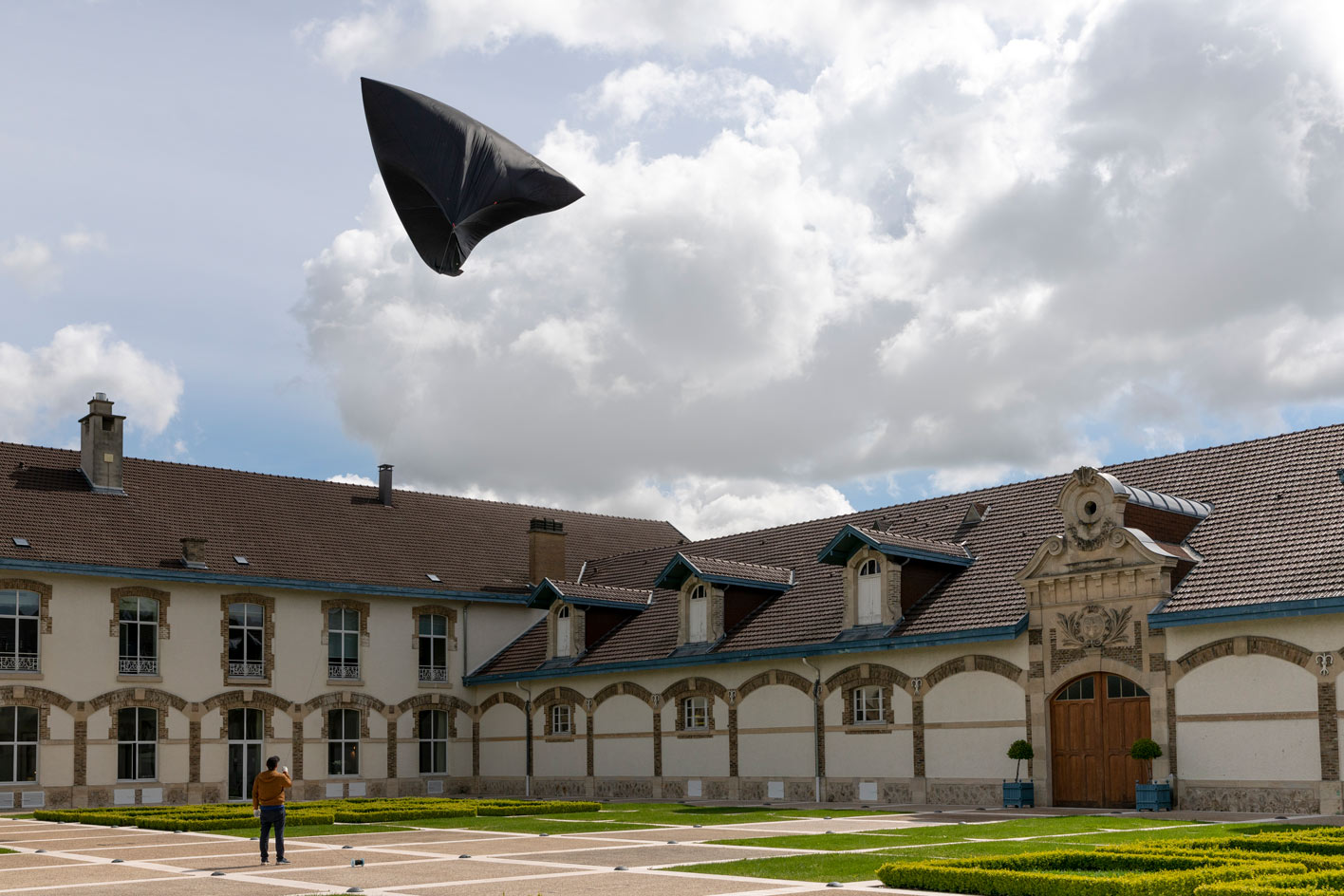
It was the evening before the Argentine artist Tomás Saraceno was to present his Aerocene project in the sky above Maison Ruinart, and dinner was being served 38m underground.
As guests sipped a 2006 Dom Ruinart Blanc de Blancs in the champagne house’s magnificent crayères, the 19th-century chalk quarries where some of the world’s best bottles are aged, Saraceno made a short speech. He wondered about the weather forecast – both for the next day and 100 years in the future. He said there is a part of Argentina where indigenous people know it will rain just by looking at the colour of spiders. But for most people, he said, ‘the only way to know about the weather is to look at their iPhone. And [here in the crayères] there is no Wi-Fi!’ Maybe, he suggested, we needed to change our way of sensing the world.
In any case, the weather was worrying him. If it rained the next day, as it had unceasingly for weeks, his performance would have to be cancelled.

Argentine artist Tomás Saraceno pictured in the vineyards at Maison Ruinart where he staged the latest chapter in his Aerocene project
Saraceno’s Aerocene project is part of a ten-year countdown to the 300th anniversary of Ruinart’s founding in 1729. Each year, the house has commissioned a different artist or architect to create a work that deals with sustainability. As Ruinart’s president, Frédéric Dufour, explained, ‘We believe that art has the power to connect people and make the world better.’
The year 2029 is also perilously close to the UN deadline for humanity to save the planet from the climate crisis. Saraceno is passionately devoted to that goal. His work – with everything from spider webs to cloud cities – aims to change the way that humans inhabit the Earth.
Aerocene is an open-source, interdisciplinary community project that explores alternatives to fossil fuel-powered flight. Rather than flying, Saraceno proposes that we embrace drifting, attached to an aerosolar sculpture that is propelled by only the sun and the wind. And, he pointed out, if land art is an accepted concept, why not sky art?
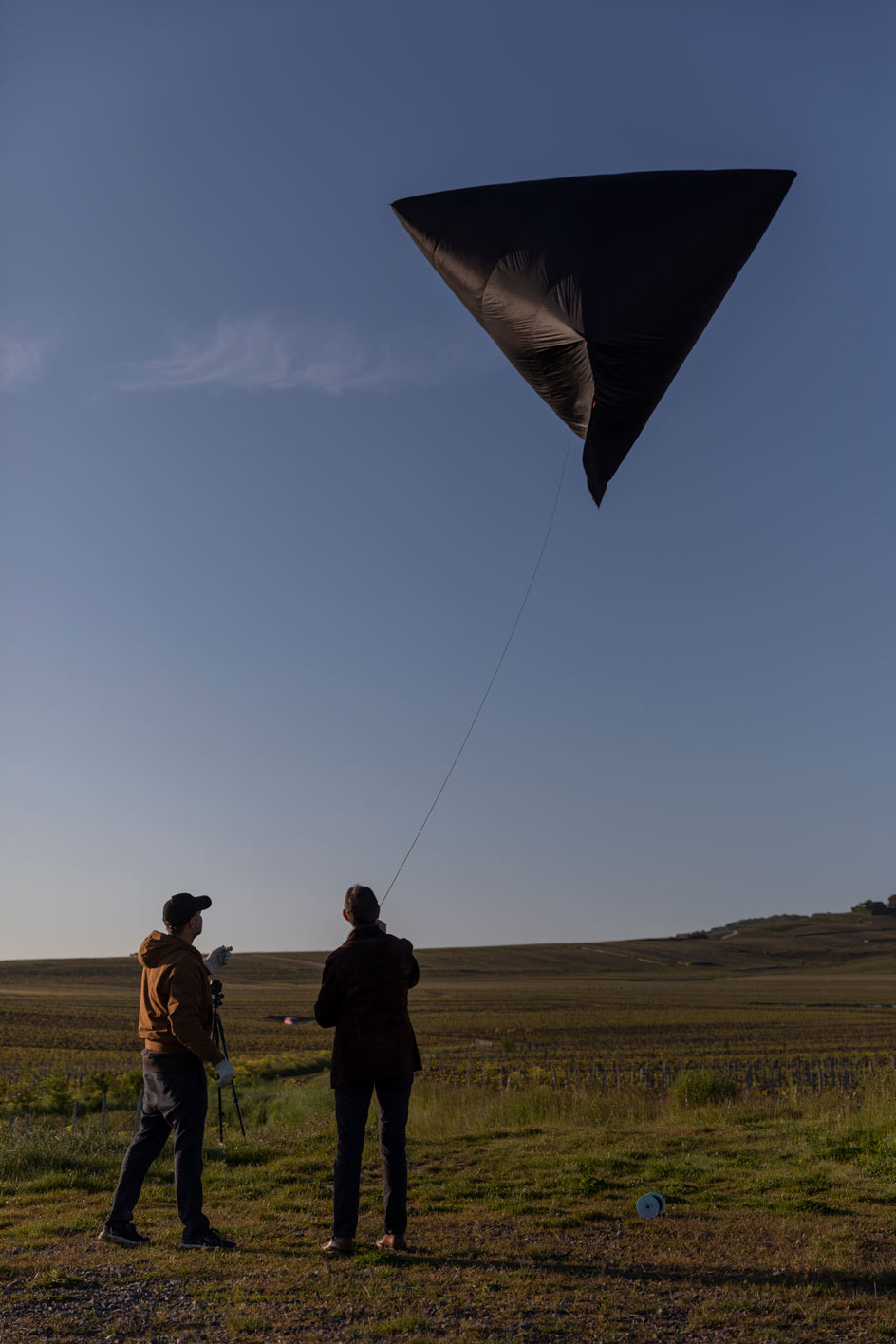
Tomás Saraceno with Ruinart’s cellarmaster, Frédéric Panaiotis, in the vineyards at Maison Ruinart with an Aerocene sculpture
The next morning, after many glasses of champagne and very little sleep, the guests congregated at 8am in the Ruinart courtyard, under a blue, nearly cloudless sky – a small miracle. Saraceno asked us to stand in a circle and meditate for a moment, listening to the birds. Afterwards his assistant, Lucía Cash, read a text about floating rather than flying as ‘a necessary future’. Lorenzo Malloni, an Aerocene flight trainer, put an Aerocene Backpack on the ground and unfolded a black nylon aerosolar sculpture.
Assisted by one of the guests (Garance Primat, who will install one of Saraceno’s aerial structures at her Domaine des Etangs estate in 2022), Malloni grabbed the sculpture at its opening and ran around the courtyard for several minutes. Slowly, it filled with air and swelled up to become an enormous, triangular, inflated pillow.

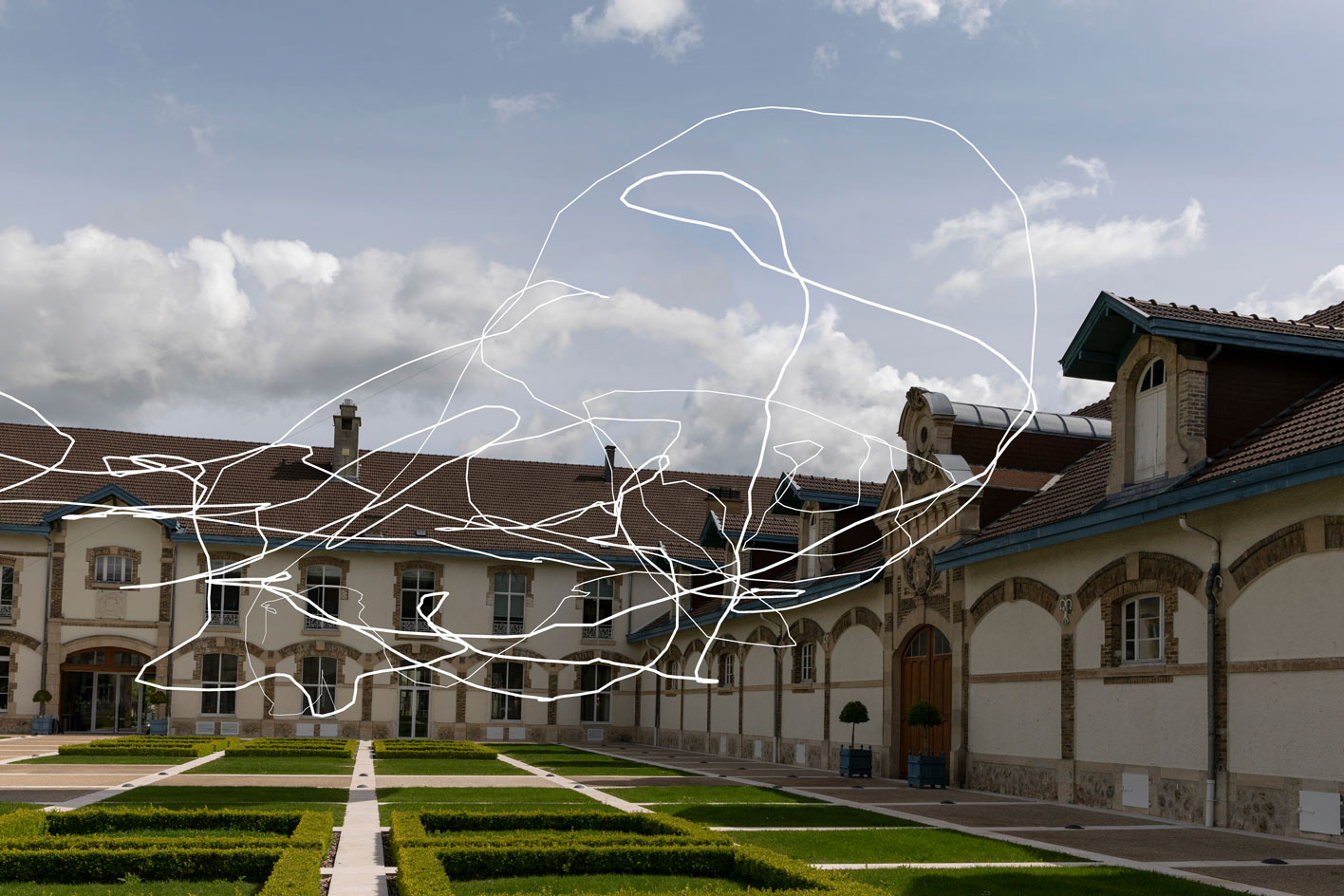
The aerosolar sculpture acts like an artist’s brush, creating an invisible trail in the sky that mirrors nature’s rhythms. This is then converted into a digital drawing, or what Saraceno calls an ‘Aeroglyph’
Saraceno tied off the opening with a length of rope attached to a spool and started to walk the sculpture slowly around the courtyard, waiting for the air inside to be heated by the sun. As he walked back and forth, it followed, turning like a wild horse on a lead, rising a few centimetres from the ground, then gently touching down again.
And then, suddenly: flight. The sculpture drifted silently up into the air, the moon still faintly visible behind it. It used no fossil fuels, no flame – just the sun and the wind.
When it momentarily floated back to ground level, Saraceno and Malloni attached several instruments to the bottom, including a GPS tracker to record the flight path. The aerosolar sculpture acts like an artist’s brush, creating an invisible trail in the sky that mirrors nature’s rhythms. This is later converted into a digital drawing, or what the artist calls an ‘Aeroglyph’. He compared the meandering line to a signature: ‘I’m trying to read that drawing. What the sun and wind are telling us. If we write these letters, pronounce them, it’s a new way of speaking.’
RELATED STORY

Tomás Saraceno, towards an Aerocene era, Making of Movement, 20.05.2021 Reims, France. Augmented reality Aeroglyphic sculpture formed by a site-specific trajectory made with the Aerocene Backpack, sensed through the Aerocene app. A movement to free the air from fossil fuels, lifted only by the air and sun and moved by the wind. For Maison Ruinart
The Aeroglyph would be uploaded to the Aerocene app, making this ephemeral experience available in augmented reality to a global community. Saraceno wants the app to serve as an interface and decentralise his activities. (He is the rare artist who dreams that others will copy his work.) Anyone can send an email to the non-profit Aerocene Foundation, borrow an Aerocene Backpack, and try it out themselves.
The Aerocene project has also achieved human flight, using only solar power to carry people up to 2km away. In an ideal world, Saraceno said, he would have made the journey from his home to Ruinart this way. ‘Though the wind direction is not the best coming from Berlin – I would go to Russia, Japan, America, and then Reims.’
A few guests took turns putting on gloves and piloting the sculpture. The experience was by turns meditative and challenging, as the wind currents had their way. Ruinart’s cellarmaster, Frédéric Panaiotis, compared the sensation to free diving: ‘Tension, then lightness.’ Indeed, Saraceno often cites Evangelista Torricelli, a student of Galileo, who said we live at the bottom of an ocean of air.


Later that morning, the group moved to the vineyards, to repeat the performance. The wind was higher now, and it took three people to hold onto the rope. The sun was also strong, and while some guests rode bicycles through the vines, others sought out the shade.
Panaiotis has long seen the creeping menace of climate change in the vineyards. In 30 years, the average temperature in Champagne has risen by 1.3 degrees Celsius. The grapes are ripening more quickly, the harvest starting earlier. Unseasonably mild weather last winter followed by a cold snap in April destroyed an estimated 20 per cent of the champagne crop in one night. Panaiotis pointed out branches that were killed by the frost, patches of mildew on leaves and dangerous moths. ‘We live with it, but it’s getting more and more challenging,’ he said. ‘One degree for most people is nothing. But for us, it’s a lot.’
Ruinart has started nurturing biodiversity in its vineyards, planting hedges around them, attracting birds and insects. This fall, after the harvest, they will take the unprecedented measure of ripping out hundreds or even thousands of invaluable grape vines and replacing them with plants and hedges in and among the vines. They know this will affect their bottom line, at least in the short term. So why are they doing it? ‘Because we can afford it,’ said Panaoitis. ‘And we want to set an example: look, it’s possible.’
He believes that Aerocene can help awaken others to the reality of climate change. ‘This takes a phenomenon that is invisible for most people and makes it visible. You see that the difference of only plus 1 degree Celsius makes it float, while minus 1 degree Celsius can kill young vines.’
The flight was now complete, and Saraceno’s team packed up the Aerocene Backpack, which Ruinart would keep. After lunch and another few glasses of champagne, the guests departed, each with a small Chardonnay vine to plant at home. The next day, it started to rain again.
Wallpaper* Newsletter
Receive our daily digest of inspiration, escapism and design stories from around the world direct to your inbox.

Tomás Saraceno and Frédéric Panaiotis in the vineyards at Maison Ruinart

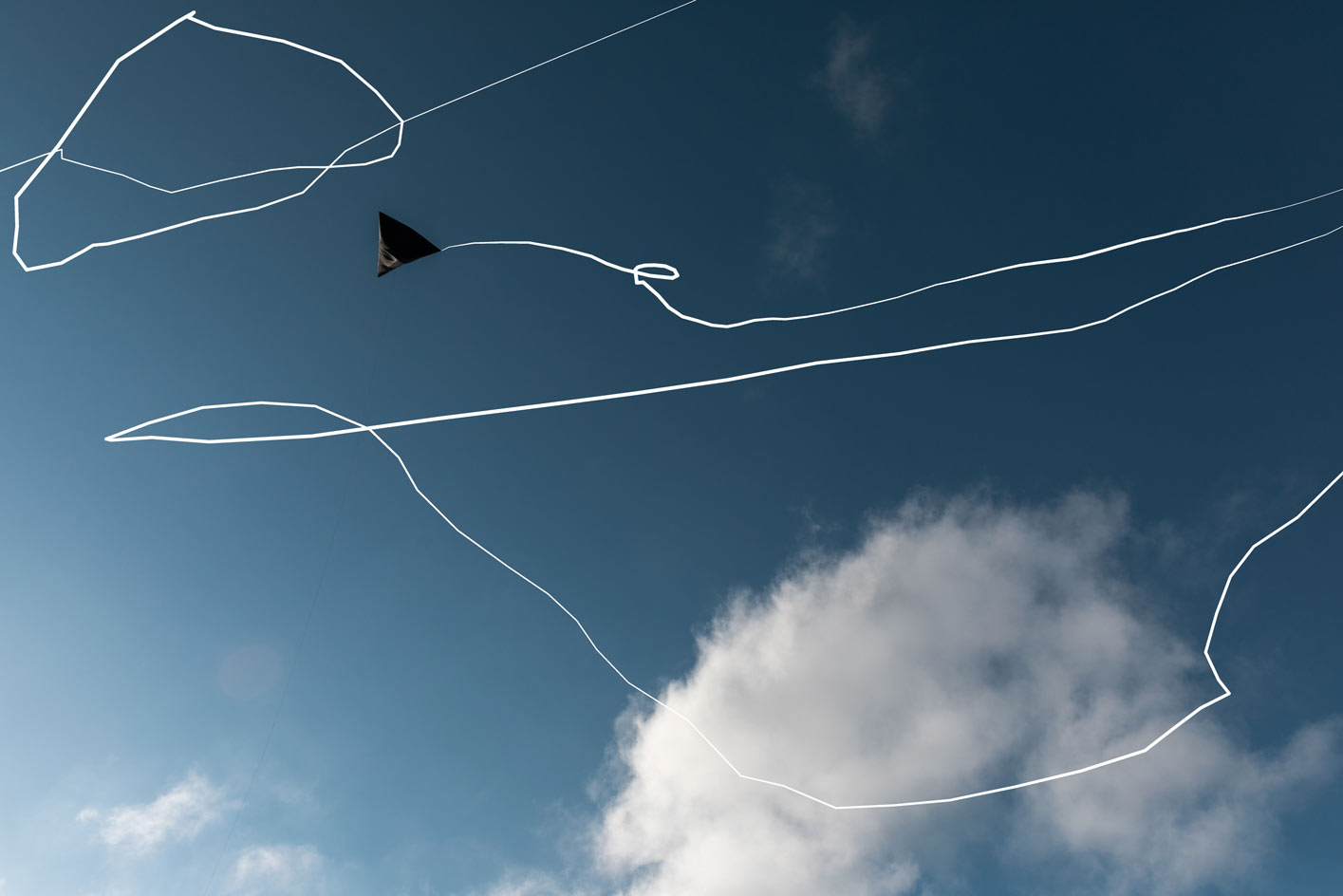
Tomás Saraceno, towards and Aerocene era Making of Movement [49.190091, 4.064507] 20.05.2021 Reims, France. augmented reality Aeroglyphic sculpture for Maison Ruinart

INFORMATION
-
 Tour the best contemporary tea houses around the world
Tour the best contemporary tea houses around the worldCelebrate the world’s most unique tea houses, from Melbourne to Stockholm, with a new book by Wallpaper’s Léa Teuscher
By Léa Teuscher
-
 ‘Humour is foundational’: artist Ella Kruglyanskaya on painting as a ‘highly questionable’ pursuit
‘Humour is foundational’: artist Ella Kruglyanskaya on painting as a ‘highly questionable’ pursuitElla Kruglyanskaya’s exhibition, ‘Shadows’ at Thomas Dane Gallery, is the first in a series of three this year, with openings in Basel and New York to follow
By Hannah Silver
-
 Australian bathhouse ‘About Time’ bridges softness and brutalism
Australian bathhouse ‘About Time’ bridges softness and brutalism‘About Time’, an Australian bathhouse designed by Goss Studio, balances brutalist architecture and the softness of natural patina in a Japanese-inspired wellness hub
By Ellie Stathaki
-
 Inside Jack Whitten’s contribution to American contemporary art
Inside Jack Whitten’s contribution to American contemporary artAs Jack Whitten exhibition ‘Speedchaser’ opens at Hauser & Wirth, London, and before a major retrospective at MoMA opens next year, we explore the American artist's impact
By Finn Blythe
-
 Frieze Sculpture takes over Regent’s Park
Frieze Sculpture takes over Regent’s ParkTwenty-two international artists turn the English gardens into a dream-like landscape and remind us of our inextricable connection to the natural world
By Smilian Cibic
-
 Harlem-born artist Tschabalala Self’s colourful ode to the landscape of her childhood
Harlem-born artist Tschabalala Self’s colourful ode to the landscape of her childhoodTschabalala Self’s new show at Finland's Espoo Museum of Modern Art evokes memories of her upbringing, in vibrant multi-dimensional vignettes
By Millen Brown-Ewens
-
 Wanås Konst sculpture park merges art and nature in Sweden
Wanås Konst sculpture park merges art and nature in SwedenWanås Konst’s latest exhibition, 'The Ocean in the Forest', unites land and sea with watery-inspired art in the park’s woodland setting
By Alice Godwin
-
 Pino Pascali’s brief and brilliant life celebrated at Fondazione Prada
Pino Pascali’s brief and brilliant life celebrated at Fondazione PradaMilan’s Fondazione Prada honours Italian artist Pino Pascali, dedicating four of its expansive main show spaces to an exhibition of his work
By Kasia Maciejowska
-
 John Cage’s ‘now moments’ inspire Lismore Castle Arts’ group show
John Cage’s ‘now moments’ inspire Lismore Castle Arts’ group showLismore Castle Arts’ ‘Each now, is the time, the space’ takes its title from John Cage, and sees four artists embrace the moment through sculpture and found objects
By Amah-Rose Abrams
-
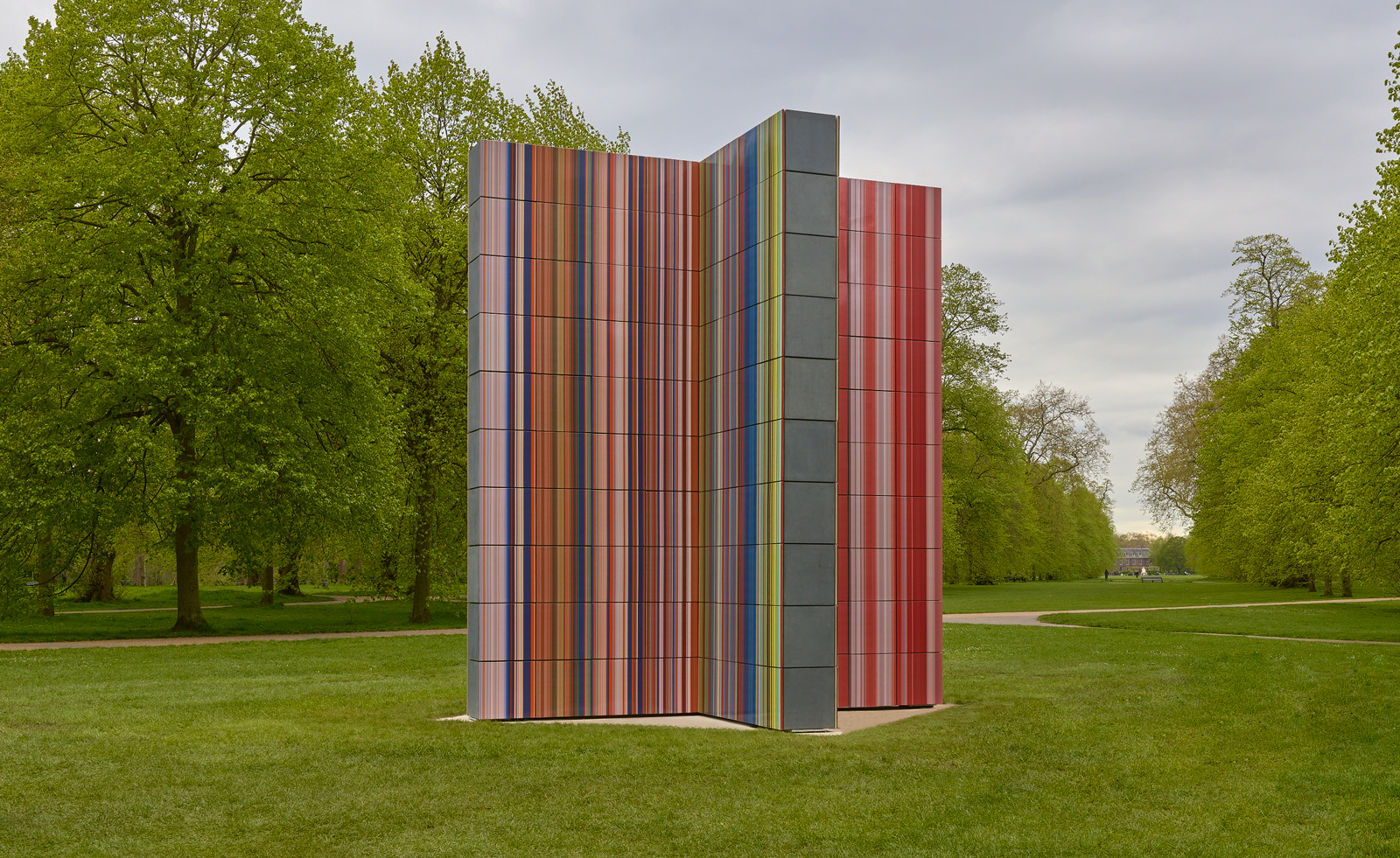 Gerhard Richter unveils new sculpture at Serpentine South
Gerhard Richter unveils new sculpture at Serpentine SouthGerhard Richter revisits themes of pattern and repetition in ‘Strip-Tower’ at London’s Serpentine South
By Hannah Silver
-
 Peter Blake’s sculptures spark joy at Waddington Custot in London
Peter Blake’s sculptures spark joy at Waddington Custot in London‘Peter Blake: Sculpture and Other Matters’, at London's Waddington Custot, spans six decades of the artist's career
By Hannah Silver
